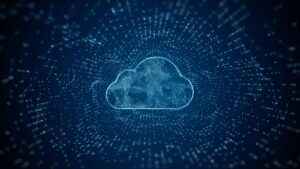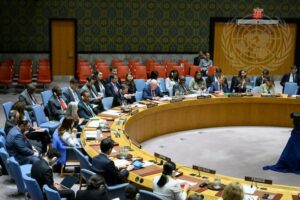Introduction
Since its entry into force in 1997, the Chemical Weapons Convention (CWC) and its implementing body, the Organisation for the Prohibition of Chemical Weapons (OPCW), have achieved great success in the destruction of 99 percent of declared global stockpiles of chemical weapons agents.1Note: Organisation for the Prohibition of Chemical Weapons, “OPCW by the Numbers,” 2023, https://www.opcw.org/media-centre/opcw-numbers. Accessed 1 May 2023. However, another objective of the OPCW is to prevent the re-emergence of chemical weapons, particularly by assisting CWC States Parties in controlling international transfers of dual-use chemicals and monitoring global chemical trade for discrepancies, a complex task that continues to pose many challenges.2Note: OPCW, “Preventing the Re-Emergence of Chemical Weapons,” 2023, https://www.opcw.org/our-work/preventing-re-emergence-chemical-weapons#:~:text=Awareness%20through%20Education%20and%20Outreach,importance%20of%20responsible%20scientific%20practice. Accessed 1 May 2023.
Under Article VI of the CWC, States Parties are required to declare to the OPCW the quantities of dual-use chemicals they import and export annually. The OPCW’s Technical Secretariat matches the quantities of these international transfers as part of its efforts to prevent the re-emergence of chemical weapons. However, a diversity of factors including uneven national implementation of the CWC, the lack of harmonization in industry reporting on chemical transfers, and simple human error have resulted in an increasing number of discrepancies in annual declarations made by States Parties. These discrepancies may indicate ineffective customs and border controls, incomplete implementation of the CWC by some States Parties, or, in the worst case, the potential exploitation of legitimate commerce by state and non-state actors for purposes prohibited under the CWC.
In 2021, the Stimson Center’s Blockchain in Practice program launched the Monitoring and Tracking Chemicals (MATCH) project, with financial support from Global Affairs Canada’s Weapons Threat Reduction program. The objective of the MATCH project was to develop a proof-of-concept software system to test the use of distributed ledger technology (DLT, also known as blockchain technology) to improve the accuracy of States Parties’ declarations on the international transfer of dual-use chemicals. Previous Stimson DLT initiatives, such as the SLAFKA prototype3Note: The Stimson Center, “SLAFKA Prototype,” Blockchain in Practice Program, 2023. https://www.stimson.org/project/slafka-prototype/. Accessed 8 May 2023. and the ComplementingthePadlock project, demonstrated the application of blockchain technology to facilitate nuclear safeguards information management and the tracking of nuclear material, and highlighted the potential of DLT to track and secure the transportation of dual-use goods. The MATCH platform is similarly designed to process regulatory reporting on the export and import of a select number of dual-use chemicals listed on the CWC’s Schedule 2 and Schedule 3 between countries within a fictional ecosystem based on real-world trade data and national legislation. At the same time the platform enables strict permissions that allow chemical industry and national authorities to share data on chemical transfers, using a single shared distributed ledger.
A Persistent Challenge: Transfer Discrepancies in International Trade of CWC Scheduled Chemicals
Since the majority of chemicals traded internationally are not dual-use precursors scheduled under the CWC, the OPCW faces a persistent challenge in ensuring that national authorities of States Parties and members of chemical industries recognize the importance of identifying and tracking the international transfer of chemicals that have the potential to be used in the production of chemical weapons agents. As global chemical trade continues to expand and new chemicals are manufactured for peaceful commercial and industrial uses, industry and national authorities also face the increasingly complex challenge of understanding different countries’ varying requirements for declaring dual-use chemical transfers and accurately capturing trade data on scheduled chemicals for their declarations.
The CWC’s Annex on Chemicals identifies and organizes chemical weapons precursors into three schedules: Schedule 1 chemicals are subject to the most stringent controls, as most have limited utility beyond the creation of chemical warfare agents. Schedule 2A and 2A* chemicals are not typically produced in large quantities and have relatively few peaceful applications. Schedule 2B and 3 chemicals make up most of the international trade in dual-use chemicals, and have a variety of peaceful applications, such as in the manufacture of many different commodities. The CWC’s Verification Annex prescribes different quantity thresholds for chemicals in each Schedule; States Parties must declare the international transfer of any scheduled chemical that exceeds these thresholds.
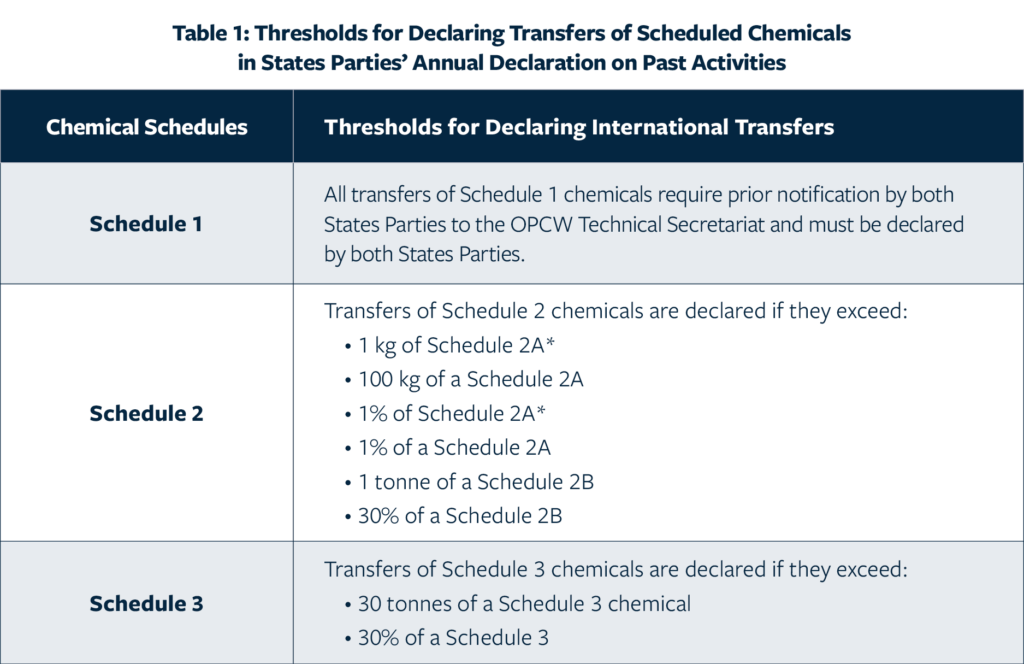
All 193 States Parties to the CWC are obligated to submit an Annual Declaration on Past Activities (ADPA) each year, including the aggregate quantities of scheduled chemicals exported and imported above prescribed thresholds. The OPCW Technical Secretariat then uses these declarations to match declared exports and imports between States Parties. Transfer discrepancies occur when the declared quantity of a scheduled chemical exported by one State Party does not match the import declaration of another, or when one state declares a transfer with another state, but that state does not declare any transfer. The OPCW Technical Secretariat works with States Parties’ national CWC authorities to reconcile these discrepancies. However, due to the complex nature of international chemical trade and several regulatory challenges, the occurrence of discrepancies in annual declarations submitted to the OPCW remains high and has increased in recent years. According to the annual report of the 26th Conference of the States Parties, ADPAs for 2019 declared 817 transfers of Schedule 2 and Schedule 3 chemicals with quantities above the thresholds for declaration, of which 581 (71 percent), involving 92 States Parties, showed discrepancies.4Note: OPCW, “Report of the OPCW on the Implementation of the Convention on the Prohibition of the Development, Production, Stockpiling and Use of Chemical Weapons and on Their Destruction in 2020,” December 1, 2021, 13, https://www.opcw.org/sites/default/files/documents/2021/12/c2603%28e%29.pdf. Accessed 1 May 2023. ADPAs for 2018 and 2017 similarly showed discrepancies in 69 percent and 66 percent of transfers, respectively.5Note: 2018 figures from OPCW, “Report of the OPCW on the Implementation of the Convention on the Prohibition of the Development, Production, Stockpiling and Use of Chemical Weapons and on Their Destruction in 2019,” April 20, 2021, 16, https://www.opcw.org/sites/default/files/documents/2021/04/c2504%28e%29.pdf. Accessed 1 May 2023. 2017 figures from OPCW, “Report of the OPCW on the Implementation of the Convention on the Prohibition of the Development, Production, Stockpiling and Use of Chemical Weapons and on Their Destruction in 2018,” November 28, 2019, 8, https://www.opcw.org/sites/default/files/documents/2019/12/c2404%28e%29.pdf. Accessed 1 May 2023.
Discrepancies arise for a number of reasons, from common clerical errors to the complexities of tracking chemical transfers through customs unions and free trade zones. The accuracy of States Parties’ ADPAs also is greatly impacted by differences among States Parties’ laws implementing the CWC and other chemical transfer regulations. For example, one State Party may enforce lower thresholds than another for industry declarations of scheduled chemical transfers, leading to reporting mismatches. Regardless of the cause, discrepancies in States Parties’ annual declarations ultimately represent the risk that quantities of dual-use chemicals may be unaccounted for and could potentially be at risk of illicit diversion for use as chemical weapons. The gradual increase in the number of discrepancies in States Parties’ declarations alongside the predicted expansion in global chemical manufacture and trade highlight the continued challenge these discrepancies pose, and the risk that illicit diversion of chemical weapons precursors could take place behind the growing “noise” of unintentional discrepancies in industry and States Parties’ declarations.
Distributed Ledger Technology — A Possible Solution?
In September 2021, the Stimson Center’s Blockchain in Practice program launched the MATCH project to determine the feasibility of using DLT to improve the accuracy of declarations on international transfers of dual-use chemicals. DLT, which is also popularly known as blockchain technology, has garnered considerable attention from various industry and private commercial interests, as well as governments, for its ability to authenticate data shared between numerous and diverse stakeholders using a single, authoritative, distributed digital ledger.
Transactions between different participants recorded on a DLT platform are cryptographically “hashed” (i.e., encoded) using a unique algorithmic key that is difficult to tamper with or reverse engineer. Each hash is combined with others to form “blocks” of encrypted data. These blocks are also hashed and linked to sequential blocks, hence the term “blockchain,” and replicated throughout the blockchain network. The constant replication of blocks of encrypted information is what gives blockchain its immutability. Hashed records are therefore “append-only,” granting the platform’s participants full provenance over the history of transactions associated with a particular set of data. DLT therefore ensures the traceability of data transacted within its ecosystem.
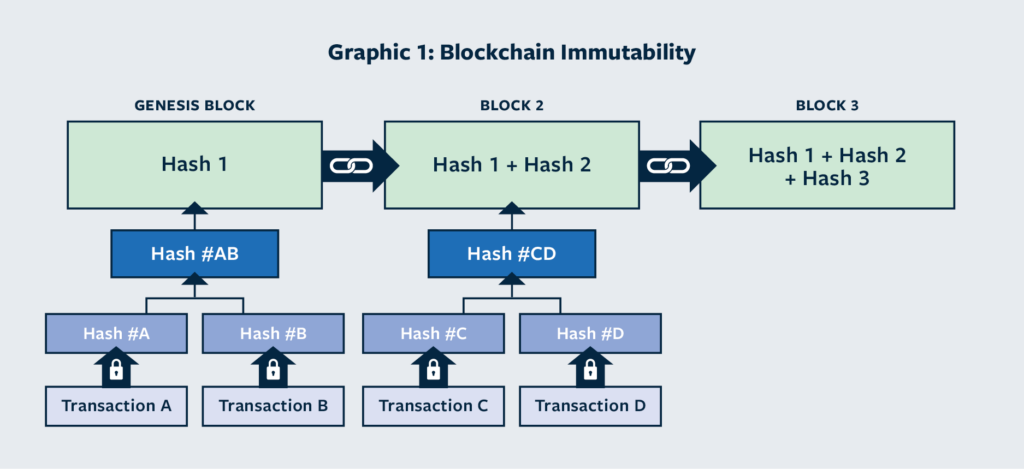
Unlike databases that traditionally have relied on a central authority to validate transactions, or a public record where anyone can view transactions, a DLT platform can be designed to include permissions to regulate each participant’s level of access and the transactions they may perform. This allows multiple stakeholders to access, transact, and store information in real-time with significantly greater efficiency and automation, which can ultimately simplify and reduce administrative processes.
Thanks to these innovative features of DLT, government and commercial applications of permissioned blockchain networks in areas such as supply chain management and logistical support are becoming more widespread. PharmaLedger, a blockchain health care solution project that began in 2020 and is now in its final year of development, is being tested by 12 pharmaceutical companies (including Pfizer, Bayer, and GSK) and 17 private and public organizations (including regulatory, legal, and academic institutions) to determine the platform’s ability to offer efficient and secure cross-company data sharing, medical goods traceability, and measures to prevent the counterfeiting of pharmaceuticals.6Note: PharmaLedger, “PharmaLedger Year 2 — First Generation Blockchain Platform Deployed,” December 2021, https://pharmaledger.eu/wp-content/uploads/PharmaLedger-2021-Year-End-Press-Release_FINAL.pdf. The De Beers Group, the world’s largest diamond supplier, uses its Tracr blockchain platform to provide an immutable record of each diamond’s origin and production to assure customers that products are ethically sourced.7Note: De Beers Group, “De Beers Group Introduces World’s First Blockchain-Backed Diamond Source Platform at Scale,” May 5, 2022, accessed December 15, 2022, https://www.debeersgroup.com/media/company-news/2022/de-beers-group-introduces-worlds-first-blockchain-backed-diamond-source-platform-at-scale. Accessed 10 May 2023. In 2018, South Korea’s Customs Service began a pilot program to test the application of blockchain technology to increase the efficiency of export clearance for e-commerce in partnership with 50 companies in Korea, Singapore, and Vietnam.8Note: Korea Customs Service, “Industry 4.0: Customs Innovation,” accessed December 16, 2022, https://www.customs.go.kr/english/na/ntt/selectNttInfo.do. Accessed 14 May 2023.
These recent use-cases of DLT illustrate the innovation that blockchain technology offers as a digital tool for tracking and validating sensitive data shared between diverse industry and government stakeholders. DLT enables the consistency and provenance of data across an ecosystem of different participants. Some blockchain proponents have referred to this technology as a “trust machine,” in that all participants agree to share information according to specific guidelines enacted by group consensus, while each participant or group maintains ownership of their own data.9Note: The Stimson Center, “Leading the Blueprint: International Perspectives on Blockchain for Nuclear Security” (webinar panel on emerging technology, October 7, 2020), https://www.stimson.org/event/leading-the-blueprint-international-perspectives-on-blockchain-for-nuclear-security/. Accessed 14 May 2023. It is this technological framework that uniquely allows the MATCH prototype to unite and enable participants to confidently share sensitive data on chemical transfers while benefiting from greater automation of data sharing and reporting.
Developing the MATCH Proof-of-Concept
The Stimson Center project team worked with blockchain developer OARO to design a blockchain technology proof-of-concept around a hypothetical decentralized ecosystem allowing both industry and national authority participants to utilize a single shared platform, and to demonstrate the benefits this could entail for greater harmonization of data-sharing and reporting on chemical transfers.
During the first phase of the MATCH project, the team conducted research on trade in scheduled chemicals to inform and scope MATCH’s digital ecosystem and functionality. The team used the U.N.’s Comtrade database to gather trade data on three Schedule 3 chemicals and one Schedule 2 chemical selected from a list of the world’s most traded scheduled chemicals.10Note: OPCW, “Most Traded Scheduled Chemicals 2022,” January 1, 2022, https://www.opcw.org/resources/declarations/most-traded-scheduled-chemicals-2022. Accessed 1 May 2023. According to this data, the three Schedule 3 chemicals (methyldiethanolamine, triethanolamine, and phosphorus trichloride) are exported and imported in large quantities annually by many different countries. They have a diversity of peaceful applications, from textile manufacturing and cosmetics to insecticides, but are also potential precursor components of lethal gases and chemical nerve agents. The Schedule 2 chemical, popularly known as Amgard-1045, is itself a mixture of two separate Schedule 2 chemicals. Commonly used as a flame retardant for polyester fabrics and textile coating, Amgard-1045 is also a precursor of deadly organophosphorus nerve agents.
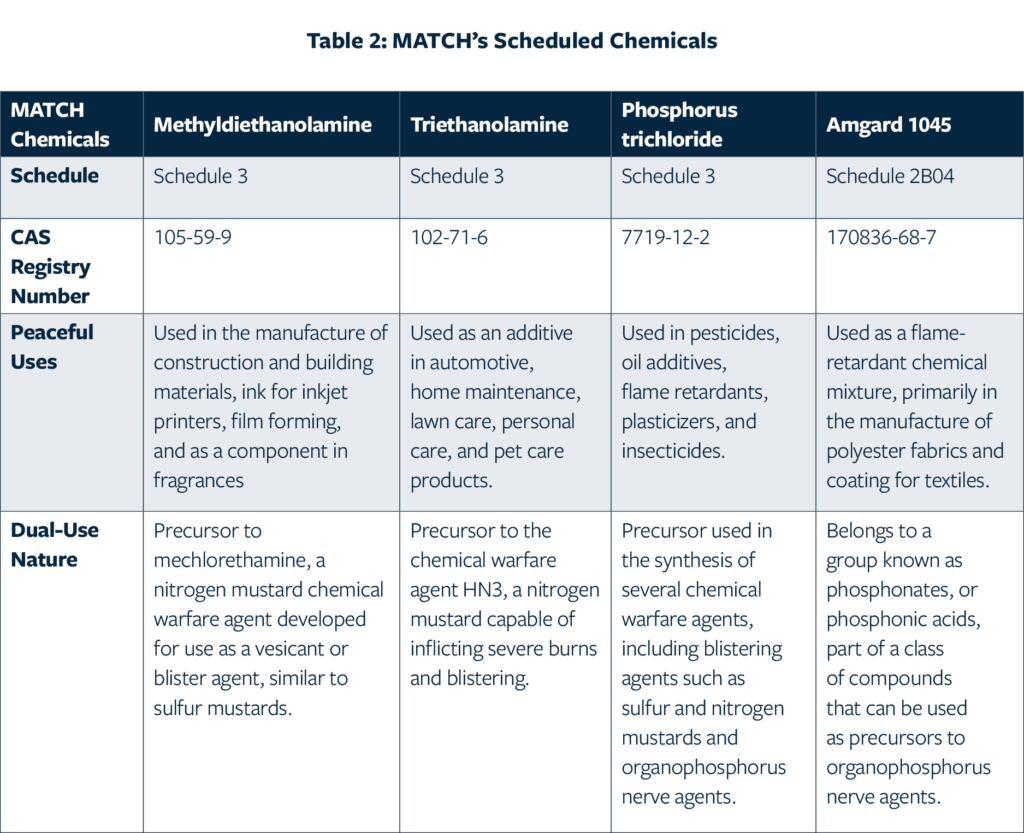
From the U.N. Comtrade data, the project team identified 31 countries whose exports and imports of these chemicals represented the greatest overall trade values and quantities transferred between 2017 and 2020.11Note: These countries were Austria, Belgium, Canada, China, Estonia, France, Germany, India, Indonesia, Iran, Ireland, Italy, Japan, Kuwait, Malaysia, Namibia, Netherlands, Poland, the Republic of Korea, the Russian Federation, Singapore, South Africa, Spain, Sweden, Switzerland, Thailand, the Republic of Türkiye, the United Arab Emirates, the United Kingdom, the United States, and Uzbekistan. The team also performed a detailed analysis of the relationship of each of these countries to the CWC and examined the status of each country’s national CWC-implementing legislation (or lack thereof). Of the 31 countries, three were determined to have no current national legislation implementing their obligations as States Parties to the CWC. The team also determined that the implementing legislation adopted by the remaining 28 countries varied significantly. For example, only 21 of the 31 countries had clearly established industry reporting thresholds above which national industries were required to declare imports and exports of scheduled chemicals. Of these 21 countries, a majority required declaration at thresholds identical to those stipulated in the CWC for annual declarations by national authorities, while four had implemented lower thresholds for industry declarations. A key takeaway from the project team’s research was the general lack of standardization of regulatory and declarations requirements for chemical industry across different countries.
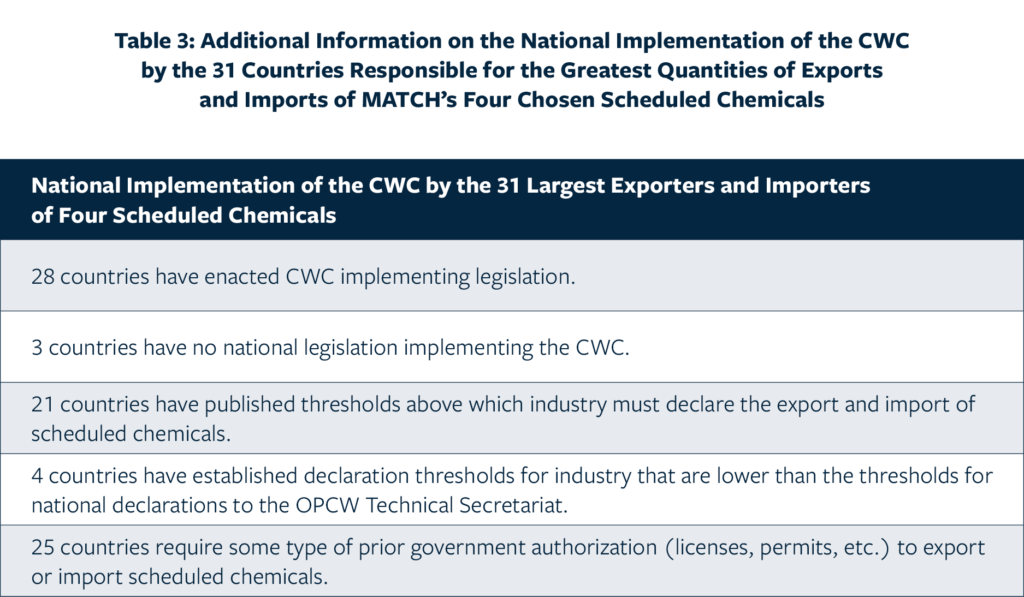
During the scoping for MATCH’s ecosystem and functionalities, the project team also held regular consultations with a group of OPCW representatives from across the Technical Secretariat’s branches and staff, collectively known as the DLT Reflection Group. The expertise volunteered by OPCW staff members ensured the project’s accurate understanding of the chemical data retrieved and the more complex aspects of the CWC, such as the declarations thresholds for annual declarations on past activities.12Note: OCPW, “Declaration Requirements for Scheduled Chemicals,” 2023, https://www.opcw.org/resources/declarations/declaration-requirements-scheduled-chemicals. Accessed 1 May 2023. Most importantly, the staff of the Technical Secretariat shared valuable insight into the ways in which global chemical industry and CWC national authorities collect chemical trade data for their declarations, and the diversity of causes for discrepancies in different countries’ annual declarations on past chemical transfers.
The project team also reached out to CWC national authorities and other regulators of dual-use trade goods in four of the 31 countries researched by the project team to better understand how transfer discrepancies occur in practice. These authorities provided a variety of perspectives on implementing the CWC in their respective countries, and the challenges they face in collecting accurate data on industry transfers. Among other issues, they raised the uneven implementation of the CWC across States Parties, and the regulatory complexities of declaring transfers to states that are not party to the CWC. Some also acknowledged that not all CWC national authorities benefit from the same level of authority or allocation of resources from their respective governments. In addition, authorities and regulators noted that a frequent cause for discrepancies in declarations arose from difficulties calculating the quantity of pure scheduled chemicals present in mixtures containing other chemicals not subject to regulation under the CWC, which could result in mismatches in the aggregate quantities of chemical imports and exports that countries declare in their ADPAs.
Consultations held by the project team with numerous representatives from global chemical industries highlighted similar challenges to the accuracy of industry declarations on past chemical transfers. Industry experts on CWC compliance reporting and responsible management of chemicals emphasized the variation in national regulations and declaration requirements as a significant challenge to the accuracy of industry declarations on dual-use chemical transfers. While the CWC obligates States Parties to declare cross-border transfers of scheduled chemicals based on their physical transfer from one country to another, some CWC national authorities instead collect data on industry imports and exports based on invoice records, which are not necessarily processed in the country where the responsible company made the transfer. States Parties also often implement different standards for industry declarations regarding chemical mixtures. While one CWC national authority may require industry to declare all quantities of pure scheduled chemical present in a mixture, others may only require declarations of quantities in mixtures above a certain percentage threshold.
Based on the research and analysis of the national CWC implementation legislation of 31 countries and insights from consultations with OPCW officials, CWC national authorities, and chemical industry representatives, the project team developed nine scenarios to test the overall functionality of the MATCH proof-of-concept, which are laid out in Section VI of this report.
MATCH software was developed using Hyperledger Besu, a flexible and widely accessible Ethereum-based platform that allows for building in permissioned access controls.13Note: Hyperledger Foundation, “Hyperledger Besu,” 2022, https://www.hyperledger.org/use/besu. Accessed 12 May 2023. Hyperledger Besu minimizes environmental impact compared to other blockchain solutions because of the platform’s capability to implement a Proof-of-Authority consensus mechanism, as opposed to popular alternatives, such as Proof-of-Work and Proof-of-Stake, which are more energy-intensive. MATCH is hosted by the LACChain blockchain network, a globally accessible nonprofit blockchain provider based in Latin America and the Caribbean.14Note: LACNet, “LACChain: Blockchain,” 2023, https://www.lacchain.net/the-blockchain. Accessed 12 May 2023. Specifically, the MATCH “nodes,” or points of access to the LACChain network, are located on the “Mainnet,” a permissioned blockchain network that requires new participants to apply to receive access, as opposed to being open for public access.15Note: LACNet, “Permissioning,” 2023, https://lacnet.lacchain.net/permissioning/. Accessed 12 May 2023.
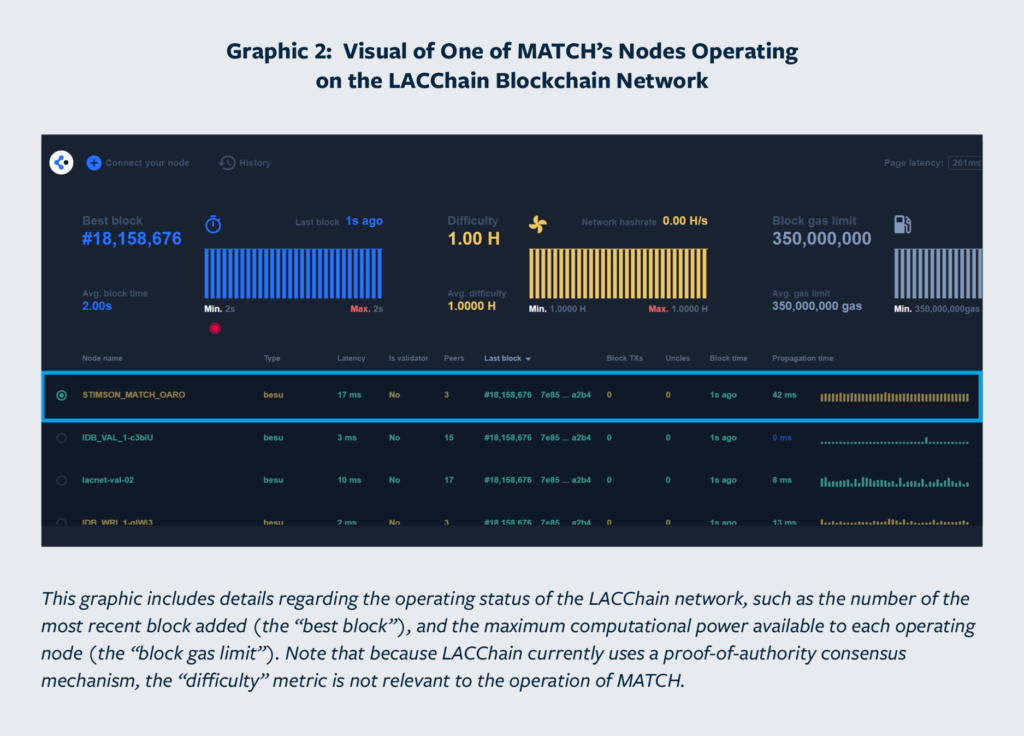
This graphic includes details regarding the operating status of the LACChain network, such as the number of the most recent block added (the “best block”), and the maximum computational power available to each operating node (the “block gas limit”). Note that because LACChain currently uses a proof-of-authority consensus mechanism, the “difficulty” metric is not relevant to the operation of MATCH.
The MATCH Ecosystem
The MATCH prototype is designed to simulate a realistic but simplified hypothetical ecosystem composed of three types of stakeholders or participants: “entities,” “national authorities,” and a “World Authority.”
Entities
Within MATCH’s ecosystem, entities broadly represent the global commercial and industrial actors responsible for transfers (exports and imports) of scheduled or dual-use chemicals across national borders. For the purposes of testing, six fictional entities were created to share information related to the export and import of chemicals traded among them and to report the quantities of chemicals transferred to their respective national authorities.
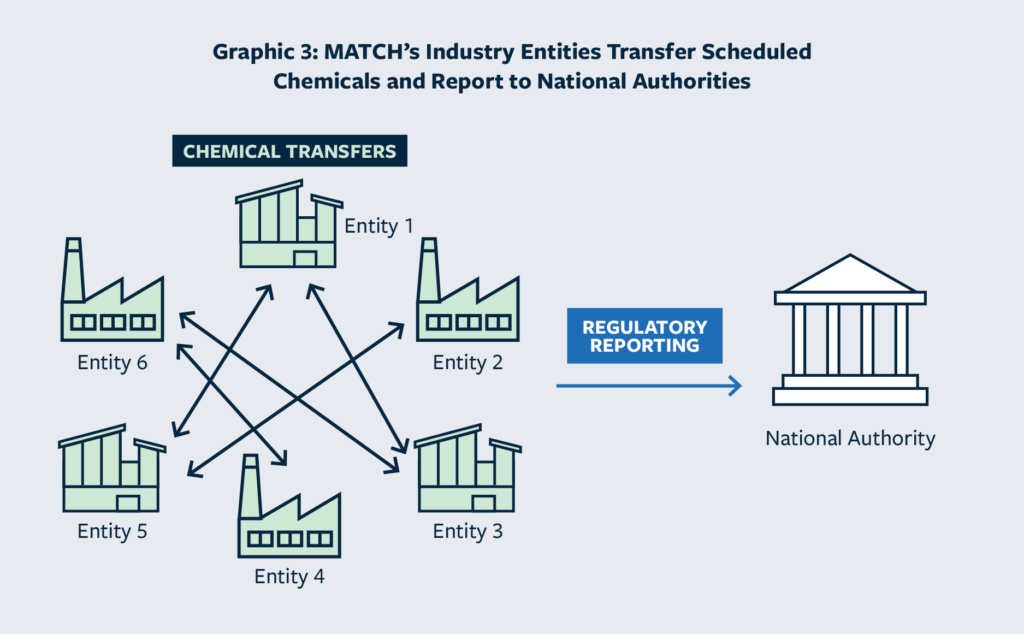
Each chemical transaction on MATCH begins when an industry entity submits an export form to record the export of one of MATCH’s four chosen scheduled chemicals. Entities create export and import records to share key information on the dual-use chemicals they trade with their foreign trade partners, such as the chemical’s schedule under the CWC, International Union of Pure and Applied Chemistry (IUPAC) name, CAS Registry number, associated Harmonized System Code, and the quantity and concentration (purity) of the scheduled chemical in each transfer. Importing entities then receive automatic notifications of pending exports that contain a QR code from which the importer may create an import form that is automatically populated with data from the export record.
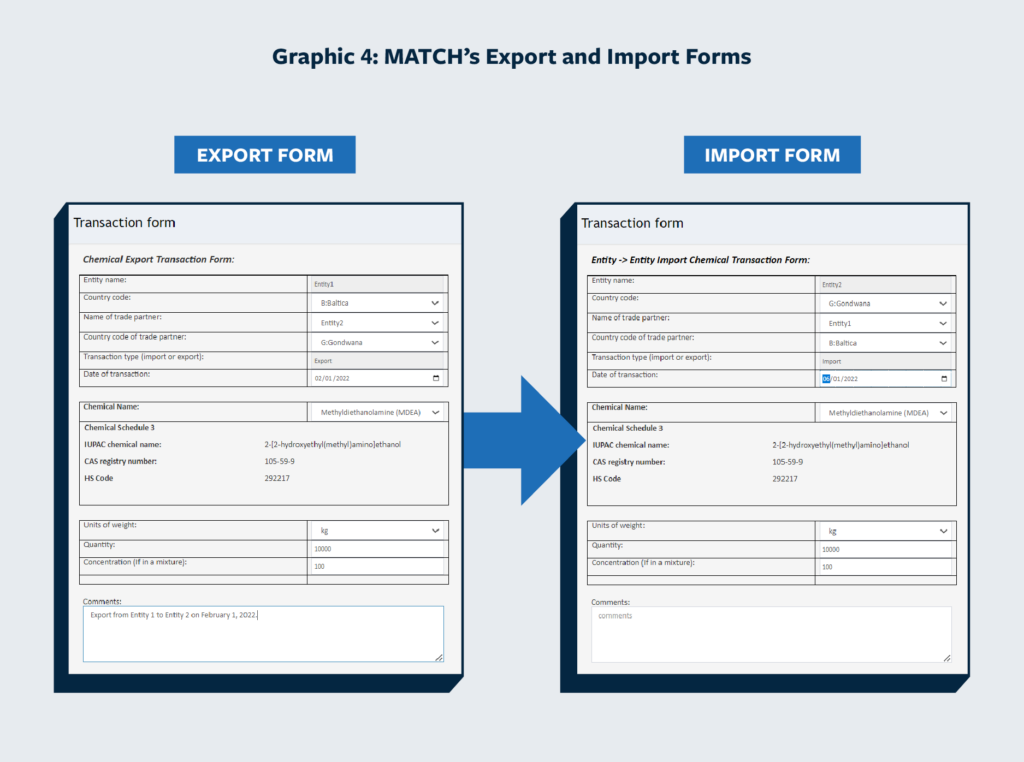
MATCH also alerts both trade partners of any discrepancies that arise in the quantities of chemicals recorded by the exporter and importer, which appear on each entity’s MATCH dashboard.
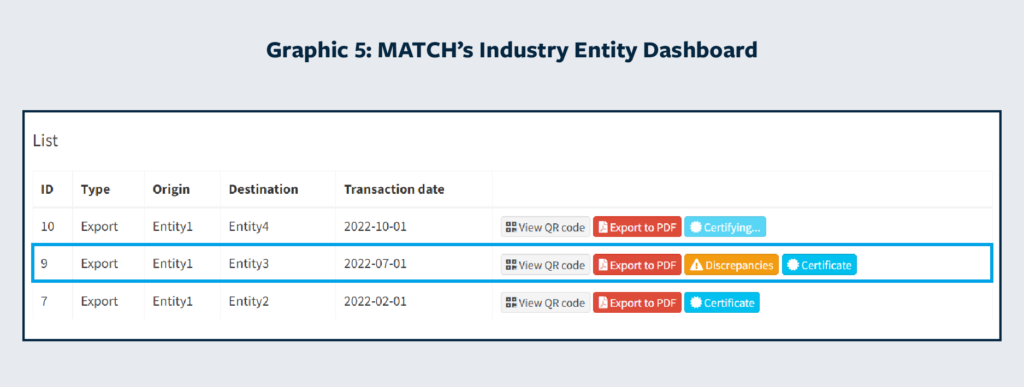
This feature potentially allows exporters and importers to identify and resolve discrepancies in their trade records before they are reported to national authorities.
National Authorities
The national authorities of five fictional CWC States Parties — Baltica, Gondwana, Laurentia, Nena, and Vaalbara — which represent the government authorities responsible for implementing the CWC. These national authorities review chemical transfer reports that entities submit on the quantities of scheduled chemicals they export and import each year. The national authorities then make declarations to the World Authority of the aggregate quantities of each Schedule 2 or Schedule 3 chemical transferred by entities to or from their countries during the previous calendar year. MATCH streamlines this process by automatically populating each national authority’s declaration with the aggregated quantities of transferred chemicals reported by entities during the previous year, organized by both chemical and the different countries participating in each transfer.
GRAPHIC 6. MATCH’s National Authorities Make Annual Declarations to the World Authority
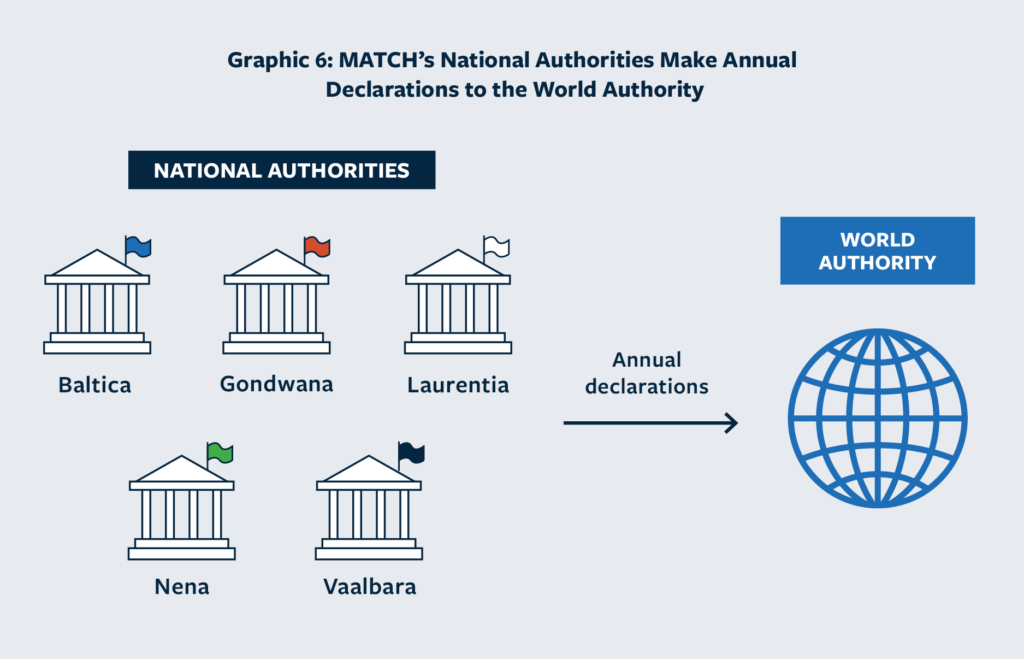
World Authority
The World Authority reviews the annual declarations submitted by the national authorities of MATCH’s fictitious States Parties for any lingering discrepancies. MATCH simplifies the World Authority’s task of reviewing individual declarations by automatically detecting discrepancies in the declared quantities of scheduled chemicals exported and imported by each State Party, flagging missing declarations, and indicating any differences in quantity between declared exports and imports.
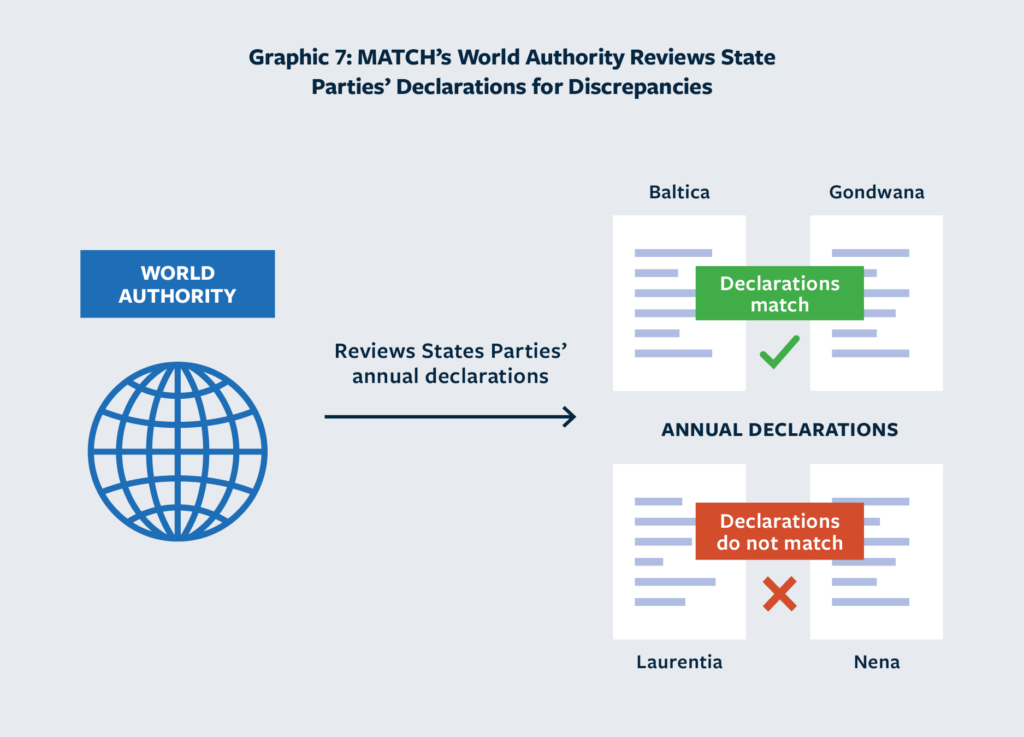
While MATCH simulates declarations requirements for industry and national authorities similar to those outlined in the CWC and in States Parties’ national implementation legislation, the platform also streamlines the process of sharing chemical trade information between industry entities while automating many aspects of the declarations process. In the real world, many transfer discrepancies are discovered only after they have been declared to the OPCW by States Parties who are often unaware of errors and missing declarations that take place at the level of industry reporting. Were industry trade partners to utilize a DLT platform similar to MATCH, discrepancies that occur in industry export and import records could be flagged and addressed before they were included in industry declarations on past transfers to national authorities.
Testing MATCH
MATCH testing occurred in two phases, as follows.
First Phase
The project team developed a series of nine chemical transfer test scenarios based on the team’s research into global chemical trade, trade figures for the project’s four chosen scheduled chemicals, and surveys of national CWC-implementation legislation. These scenarios were designed to realistically simulate international chemical transfers, but were simplified for the proof-of-concept’s virtual ecosystem.
In each scenario, entities hypothetically transferred one or more of MATCH’s four chosen precursor chemicals between two or more fictional States Parties, exchanged records of the transactions, and made reports to national authorities. National authorities in turn made declarations to the World Authority. The scenarios varied in complexity and highlighted several common causes of transfer discrepancies, including calculation errors in industry declarations, misreported chemical quantities or concentrations of scheduled chemicals in mixtures, and missing or mismatched national declarations due to transfers that went unreported by industry or national authorities. The scenarios also simulated the transfer of scheduled chemicals through free trade zones and customs unions, and transfers in which a consignment was exported in one year and imported in another, both common examples of real-world trade that can result in missing or incomplete national declarations.
Below are graphical examples of three testing scenarios. A full list of the nine MATCH testing scenarios is available in the included annex.
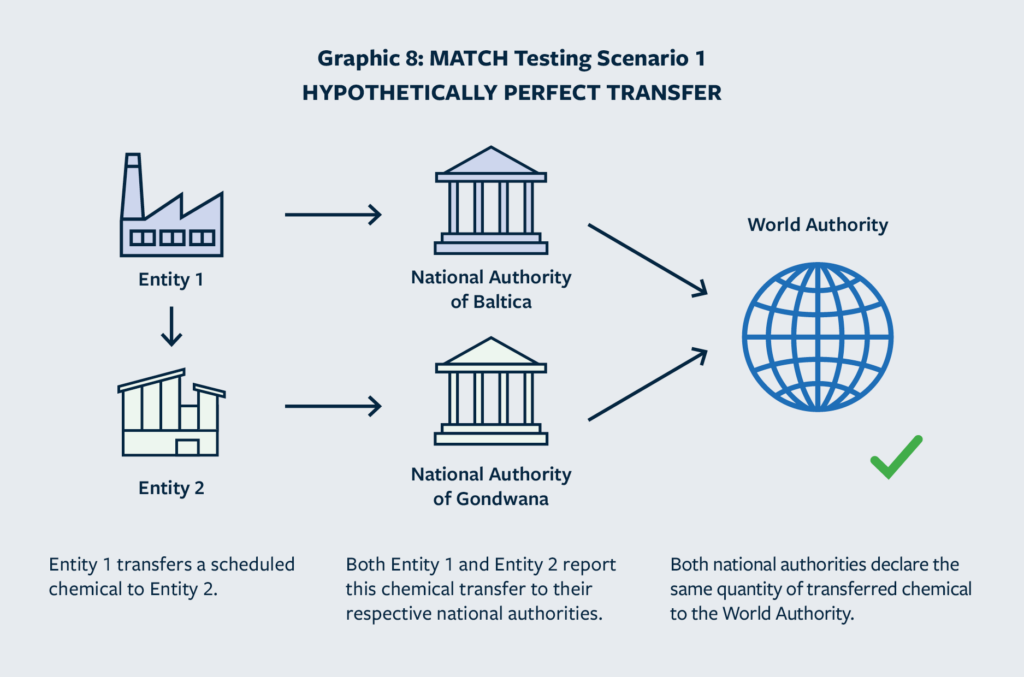
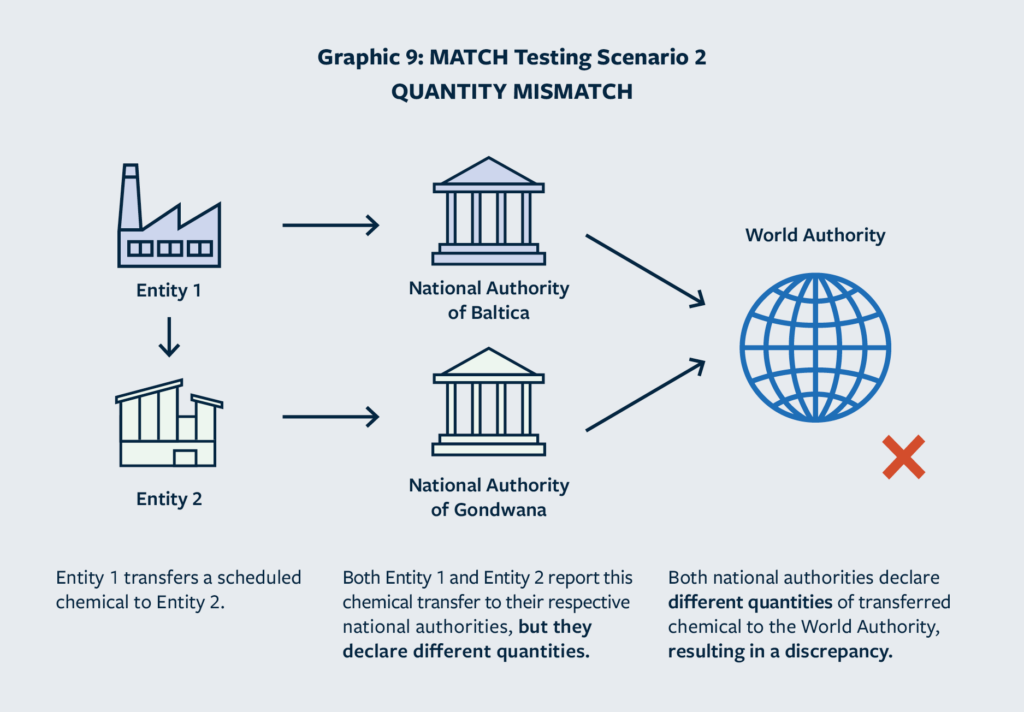
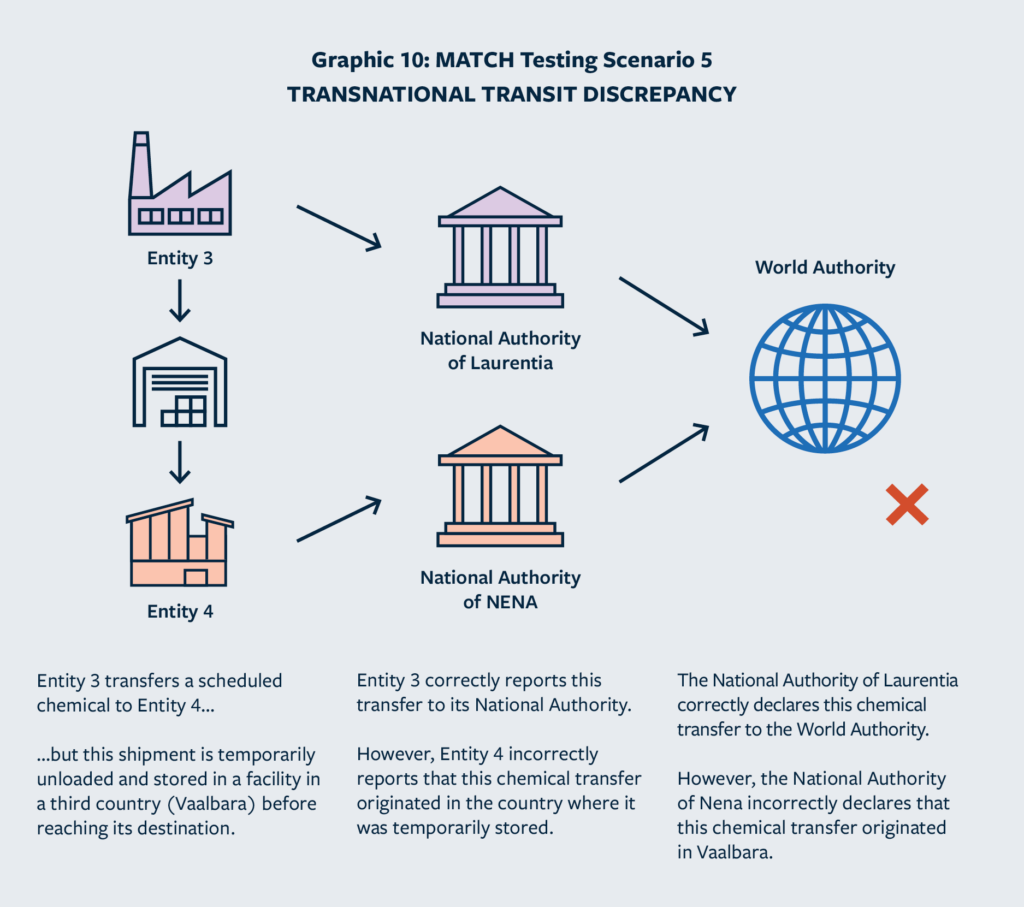
Once the project team had tested the initial nine scenarios, they produced videos illustrating three scenarios for the purposes of demonstrating MATCH to project stakeholders. These demonstrations not only helped to introduce the project to national authorities and chemical industry representatives, but also assisted in outreach to stakeholders to participate in “live” firsthand testing of the system. The team conducted a total of 15 demonstrations and tutorials on operating the MATCH platform for testing throughout the fall of 2022 for government representatives from five different countries, including four CWC national authorities and government regulators responsible for trade controls, and six groups representing different commercial chemical companies and multinational chemical industry associations.
Second Phase
The second phase, consisting of live testing, began in December 2022. Eight groups of testers representing different national authorities and chemical industries who previously participated in live demonstrations of the system volunteered their time to test the MATCH platform. While the project team provided a series of five tutorial videos to assist testers in performing simple chemical transactions and declarations, testers were also free to test any number of their own scenarios based on their own expertise or experience in conducting or declaring chemical transfers. The MATCH development team at OARO also implemented digital feedback and bug report surveys, which allowed testers to provide real-time feedback on their experiences and receive support if they encountered any technical issues. All eight testing groups provided ample feedback on their experiences with the proof-of-concept, including suggestions for new features and changes to improve the user experience, which the project team reviewed for individual follow-up with each group at the conclusion of testing.
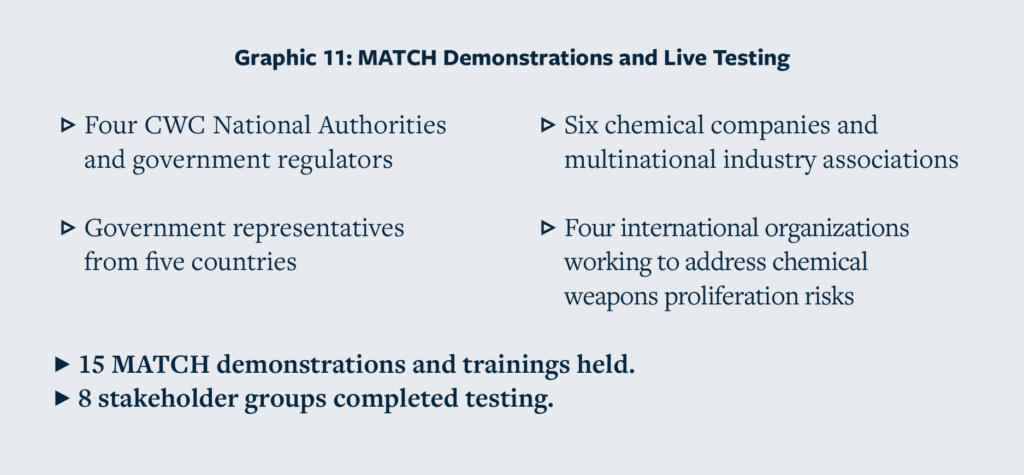
Findings and Feedback
The MATCH platform successfully demonstrated the ability to detect, and in some cases automatically resolve discrepancies across the nine test scenarios developed by the project team. Testing performed by the participants of the live testing also demonstrated the MATCH platform’s ability to flag discrepancies in a number of different chemical transfer scenarios, allowing industry entities to reconcile differences in recorded export and import quantities before reporting transfers to their national authorities. For example, MATCH immediately alerted entities to discrepancies in their transfer records when one trade partner recorded a different amount of chemical transferred (Scenario 2) or recorded the transfer of an entirely different chemical (Scenario 8). The platform also flagged discrepancies due to missing industry reports to national authorities (Scenario 3). When testers used the QR codes that MATCH provides for chemical transfer records, many discrepancies arising from simple clerical errors were prevented altogether. MATCH also correctly aggregated quantities when generating reports to national authorities and declarations to the world authority regardless of the reporting methods industry entities used — for example, recording different units of measurement or choosing to record the pure quantity of chemical transferred rather than the concentration of a mixture. In Scenario 4, in which an export and import of a transferred chemical are declared in different years, the system flags a discrepancy in the declaration received and indicates to the world authority which trade partner may be responsible for the missing declaration. Finally, for the more complex scenarios like Scenarios 6 and 7, which deal with multiple transfers within fictional customs unions and free trade zones, MATCH provided the world authority with automatic notifications of discrepancies in national authorities’ declarations, indicating both the difference in quantities declared and the countries involved.
Throughout the testing process, the project team collected a wealth of feedback for the continued development and expansion of MATCH. This feedback was organized by the team into three primary groups: 1) feedback received from chemical industry professionals, 2) responses from national authorities and regulators, and 3) suggestions from representatives of international organizations and other experts on chemical weapons nonproliferation. Though there was considerable overlap in many aspects of the feedback received, the project team also noted significant differences in the interests and focus of each group of stakeholders. Representatives from chemical industry and States Parties’ national authorities, for example, agreed on many of the common causes for transfer discrepancies in industry declarations, but also offered unique perspectives on the primary challenges they perceived in reducing the occurrence of discrepancies, as well as in adopting or implementing blockchain technology.
While most testers agreed they could see the potential of MATCH as a tool that could introduce a greater degree of standardization across industry data-sharing and reporting on transfers and significantly reduce the occurrence of many common discrepancies, both industry and national authority testers suggested ways in which the platform could be expanded to include new participants and capture more data on chemical transfers. A popular suggestion was to include the role of transporters (e.g., commercial overseas shipping enterprises, etc.) and to expand the amount of data captured on industry entity export and import forms. For example, by including transporters as a unique type of participant on the MATCH platform, export and import forms could include exact shipping itineraries and even GPS coordinate data for individual chemical consignments. Data shared from transporters could also be used to indicate when a chemical shipment was processed through customs or temporarily stored in a third country before reaching its destination.
If additional data were captured in export and import records, it could also be incorporated into the unique QR code generated by MATCH for each chemical transaction. While the QR codes currently enable industry entities to automatically populate import forms with the data shared by exporters, transporters could potentially also use the QR codes (or radio frequency identification, known as RFID, data) to assist exporters and importers in tracking the physical movement of individual transfers more accurately. Similarly, MATCH’s QR codes could, in theory, also provide customs officials with easily accessible information on a particular chemical consignment, such as the schedule of chemical being transported, any potential safety hazards, and the shipping itinerary. With improved physical tracking of chemical transfers and near real-time sharing of transfer data between exporters, transporters, and importers, both industry and national authority participants also highlighted the potential of MATCH to more effectively reduce the risk of transfer discrepancies that arise as a result of the complexities of trade within customs unions and free trade zones.
Both industry and national authority participants also highlighted the importance of reducing the risk of human error, such as typographical errors and calculation mistakes, which are common causes of discrepancies in industry declarations. By introducing greater automation to the processes of creating export and import records and industry reports to national authorities, the prototype platform may significantly reduce the occurrence of simple mistakes in reporting, and consequently reduce the number of discrepancies in industry transaction records. The platform already offers considerable automation and standardization, particularly across industry entity chemical transfer records and reports to national authorities. For example, MATCH automatically calculates differences in chemical quantities in industry export and import records and flags these discrepancies for the attention of the responsible entities. However, should two industry entities utilize different standards for recording exports and imports, for example by using different units of measurement or recording only the quantity of scheduled chemical present in a consignment rather than the percentage of a whole mixture, MATCH automatically calculates whether the specific quantities recorded are equivalent. While this standardization across industry record-keeping and reporting is simply a feature of MATCH’s application programming interface (API) and not unique to blockchain technology, the strict access protocols inherent to blockchain technology provide the trust necessary to potentially incentivize multiple private-industry entities to agree to share sensitive data using a shared platform.
Among industry participants in MATCH demonstrations and testing, a key focus or interest was on the utility of blockchain technology as a tool to enhance, rather than disrupt, the systems that industries already use to track and record data on international chemical transfers. One prominent example from industry feedback was the question of blockchain’s potential interoperability with existing industry databases and reporting systems. With greater interoperability, industry could continue to use their current systems while also benefiting from DLT as an additional layer that complemented their existing databases. MATCH’s API already allows for a great degree of interoperability with other databases, in theory, and this feature could be further developed in future phases of the project. Industry participants also highlighted the importance of increasing the automation of data entry and information-sharing between participants, especially in the case of creating export and import records, to streamline these processes and reduce the overall time and costs associated with data management.
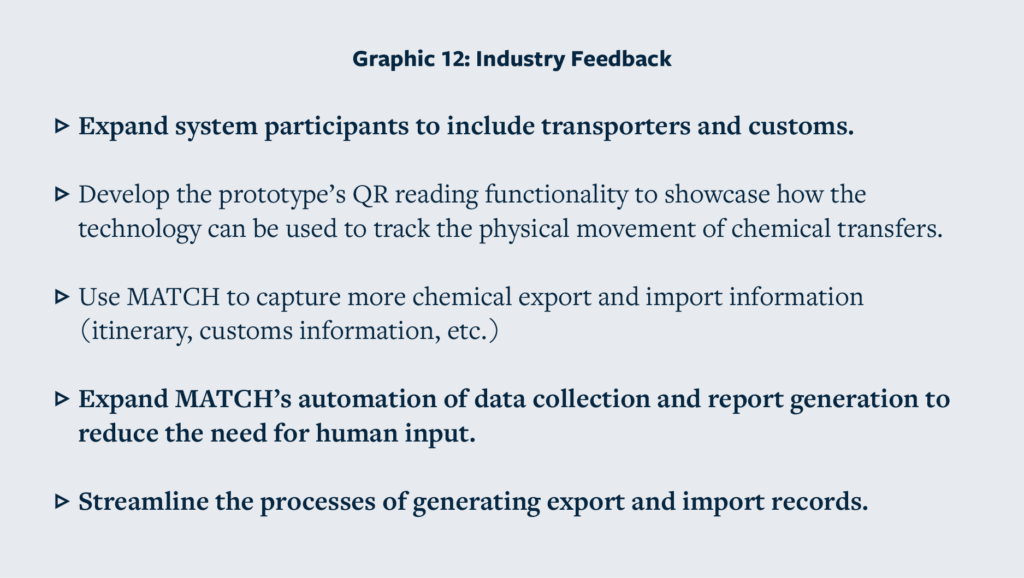
Feedback also focused on the proof-of-concept’s potential to address more regulatory, legislative, and trade-related causes for transfer discrepancies. Participants emphasized the following scenarios as being likely to result in discrepancies in real-world national authority declarations: tracking transfers that occur across calendar years (for example, when exports take place in one year, but the import is processed the following year), transfers through customs unions and free trade zones, subsequent or re-transfers of chemicals to third countries, and transfers to states not party to the CWC. National authority participants also suggested that the project team implement more varied industry-reporting requirements for each national authority to capture the diversity of real-world regulations implemented in the various national legislations of CWC States Parties. Though MATCH has simulated industry reporting requirements based on a survey of the CWC-implementing legislation of 31 States Parties, unique regulatory requirements for reporting to MATCH’s fictional States Parties could be implemented to better test the platform’s ability to enable greater standardization across industry reporting.
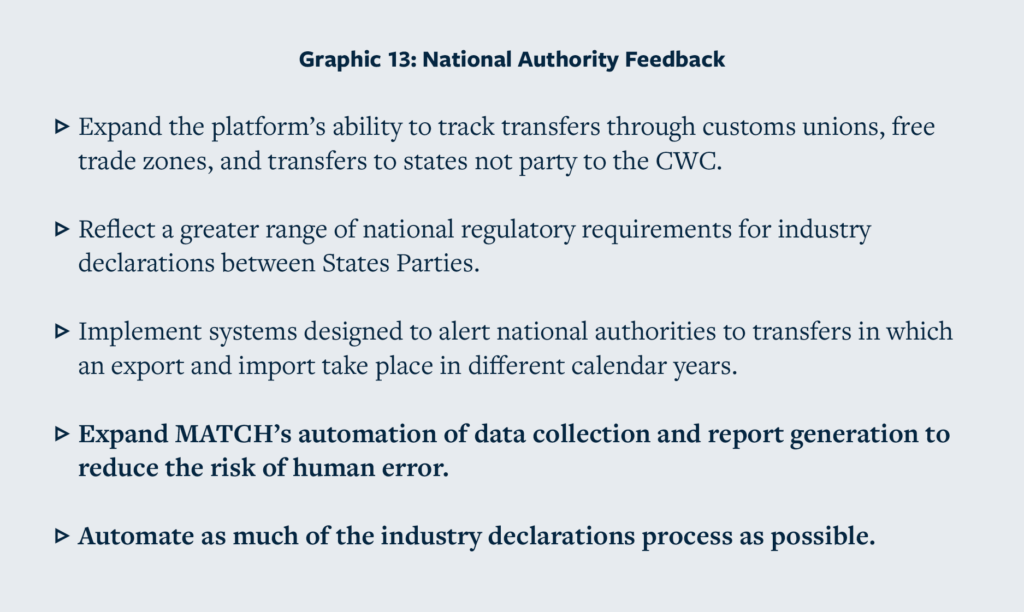
In addition to industry professionals and national authority representatives, the project team also received feedback from representatives of the OPCW, international organizations, and experts on chemical weapons nonproliferation and emerging technologies from among Stimson Center affiliates and nonresident fellows who volunteered to participate in the Blockchain in Practice program’s advisory Blockchain Working Group. During demonstrations and testing, these groups offered several suggestions for improvements and added functionalities for future iterations. Among these was the suggestion to increase the system’s accessibility by implementing additional language options for the user interface, which currently is only available in English and Spanish. Another suggestion was to implement a function that would alert national authorities to transfers of unusual quantities of Schedule 2 and Schedule 3 chemicals, such as numerous small-quantity transfers below the national thresholds for industry reporting, as well as unusually large transfers of Schedule 2 chemicals. Some experts also offered more hypothetical suggestions for future iterations of MATCH, such as the ability to also track international transfers of regulated dual-use chemical technologies, such as chemical aerosolization machines and pill compressors.
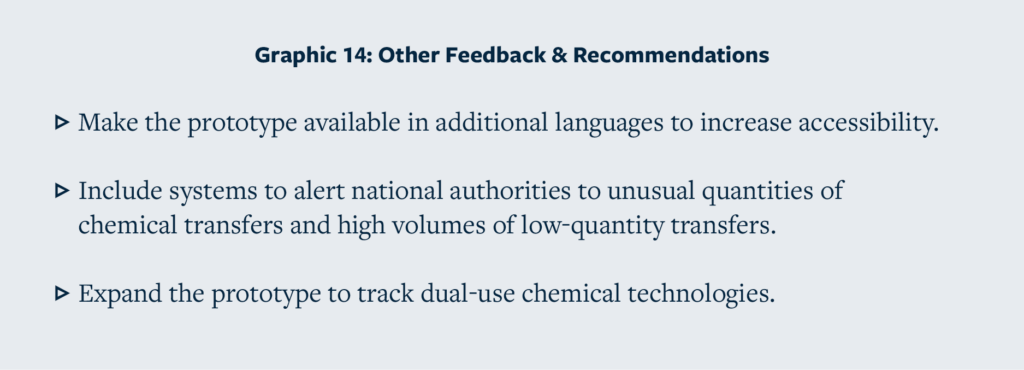
The Future of MATCH
Feedback from the second phase of MATCH has provided insight into possible next steps for improving and expanding the original proof-of-concept. To continue to test the application of blockchain technology for the purpose of reducing the occurrence of discrepancies in States Parties’ ADPAs, the proof-of-concept should be expanded both in scope and technical capacity. Not only should the MATCH ecosystem be expanded to include additional participants, such as transporters, but it must also capture a wider variety of Schedule 2 and 3 chemicals among those most commonly traded. As the project team further develops the platform’s ecosystem, more complex scenarios can be tested, and more features can be added to increase the agency of industry entities and national authorities to resolve discrepancies before they are declared to the world authority. For instance, the team would like to add the expanded use of QR codes and RFIDs to better track the physical movement of chemical shipments, and venture further in researching the interoperability of DLT and other capabilities of blockchain technology to increase the potential utility of this technology for industry stakeholders.
As MATCH is developed from this initial proof-of-concept, new test scenarios will be developed to ensure that the project is designed to comprehensively address and resolve more complex causes of transfer discrepancies while remaining in-line with real-world CWC declarations requirements and the implementing legislation of States Parties. In scoping for the next stage of development, national authorities will also be updated to feature more varied industry reporting requirements based on the project team’s research into real-world implementation legislation, to test whether MATCH’s capacity to standardize industry reporting methods may also reduce the risk of discrepancies due to differences in each States Parties’ legislation.
Increasing the project’s outreach to a variety of national authorities is also a critical focus of the next phase of MATCH’s development, which aims to socialize the project and understand the unique challenges different States Parties face in accurately declaring the transfers of scheduled chemicals each year. Consulting with national authorities from a diversity of different regions and localities may also provide key insight into other challenges, which could help ensure that any real-world system would be as accessible as possible worldwide, as well as powered by environmentally conscious technology to support national development aims as well as the U.N.’s Sustainable Development Goals. Currently, MATCH is accessible by both computer and mobile devices, but lacks many user-interface language tools for non-English speakers. While the proof-of-concept was also built using the environmentally conscious Hyperledger Besu platform, the project team will continue to explore ways to minimize potential environmental impact, especially as the platform grows to encompass more participants and larger transaction volumes.
Another critical takeaway from testing and demonstrations has been the increasing importance of consulting with industry stakeholders about the project. In developing the initial test scenarios, it became clear to the project team that a majority of discrepancies occur at the level of industry transfers, due not only to simple reporting mistakes and calculation errors but also to the complex nature of international chemical trade and the different declaration and other regulatory requirements enforced by different States Parties. The Blockchain in Practice program will actively engage in outreach to existing and potential new industry stakeholders worldwide to understand the key challenges faced by global chemical industry in accurately reporting transfers, and what other technical needs DLT may address. The project team will continue to explore the potential interoperability of MATCH and how the benefits offered by blockchain technology may be incorporated into existing systems used by industry rather than causing disruptions or resulting in additional steps for data management and reporting processes.
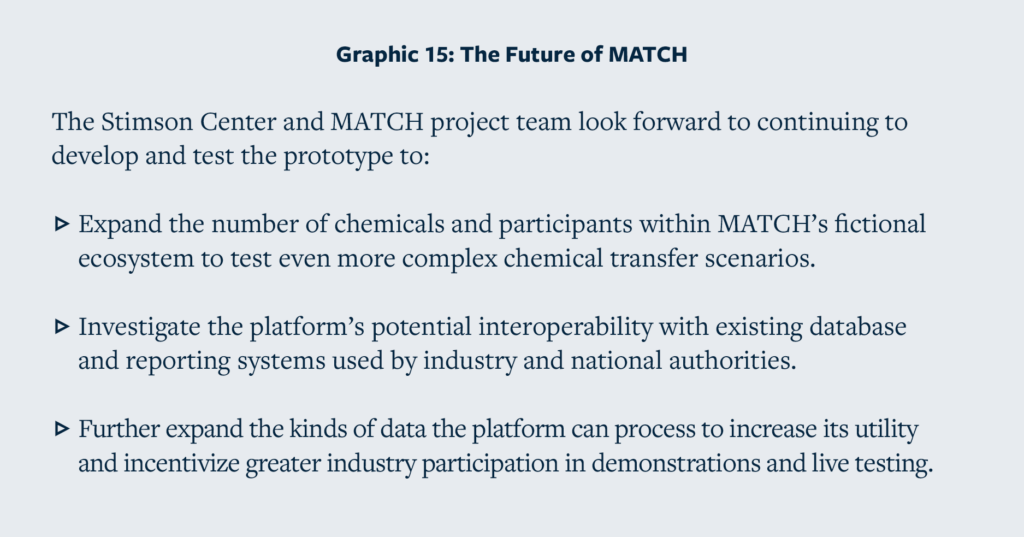
As MATCH continues to develop, feedback from industry, national authorities, and other chemical weapons nonproliferation experts will continue to inform its design and functionality, ensuring that the platform can expand and improve to better address the needs and concerns of these unique stakeholder groups in reducing the risk of chemical weapons proliferation.
Acknowledgements
The Stimson Center is grateful to Global Affairs Canada’s Weapons Threat Reduction program for financial support of the MATCH project. The project team also offers its sincerest thanks to the staff and members of the OPCW’s DLT Reflection Group and of Stimson’s Blockchain Working Group, Lovely Umayam, Jonathan Forman, Mark Albon, and Robert Rosenberg, who provided their valued expertise and guidance during the research and development of MATCH. Additionally, the Blockchain in Practice program thanks its nonresident fellows, Lovely Umayam and Cindy Vestergaard, for their time and expertise in reviewing this final report. We also thank Nonresident Fellow Michele Lunney and Alfred Lee Loomis Innovation Council member Bevon Moore for their support of the project. Finally, the program would like to thank all of the government and industry representatives who generously donated their time to participate in demonstrations and offer feedback during the live testing.
About the Authors
William Marshall is a research associate with Stimson’s Blockchain in Practice program. His research focuses on blockchain technology and its potential to strengthen nonproliferation, specifically for increasing transparency and security of data exchange related to nuclear safeguards, nuclear security, and for monitoring the international trade of dual-use chemicals.
Christina McAllister is a senior fellow and director of the Partnerships in Proliferation Prevention program at the Stimson Center. Prior to joining Stimson, Christina supported U.S. Department of Defense offices responsible for nonproliferation and countering weapons of mass destruction (CWMD).
Dr. Cindy Vestergaard is a nonresident fellow with the Nuclear Safeguards and Blockchain in Practice programs, having previously served as the director and senior fellow for both programs. She is currently vice president of Special Projects and External Relations at RKVST. To learn more about how Dr. Vestergaard got her start in nuclear safeguards, read her “My Story.”
Notes
- 1Note: Organisation for the Prohibition of Chemical Weapons, “OPCW by the Numbers,” 2023, https://www.opcw.org/media-centre/opcw-numbers. Accessed 1 May 2023.
- 2Note: OPCW, “Preventing the Re-Emergence of Chemical Weapons,” 2023, https://www.opcw.org/our-work/preventing-re-emergence-chemical-weapons#:~:text=Awareness%20through%20Education%20and%20Outreach,importance%20of%20responsible%20scientific%20practice. Accessed 1 May 2023.
- 3Note: The Stimson Center, “SLAFKA Prototype,” Blockchain in Practice Program, 2023. https://www.stimson.org/project/slafka-prototype/. Accessed 8 May 2023.
- 4Note: OPCW, “Report of the OPCW on the Implementation of the Convention on the Prohibition of the Development, Production, Stockpiling and Use of Chemical Weapons and on Their Destruction in 2020,” December 1, 2021, 13, https://www.opcw.org/sites/default/files/documents/2021/12/c2603%28e%29.pdf. Accessed 1 May 2023.
- 5Note: 2018 figures from OPCW, “Report of the OPCW on the Implementation of the Convention on the Prohibition of the Development, Production, Stockpiling and Use of Chemical Weapons and on Their Destruction in 2019,” April 20, 2021, 16, https://www.opcw.org/sites/default/files/documents/2021/04/c2504%28e%29.pdf. Accessed 1 May 2023. 2017 figures from OPCW, “Report of the OPCW on the Implementation of the Convention on the Prohibition of the Development, Production, Stockpiling and Use of Chemical Weapons and on Their Destruction in 2018,” November 28, 2019, 8, https://www.opcw.org/sites/default/files/documents/2019/12/c2404%28e%29.pdf. Accessed 1 May 2023.
- 6Note: PharmaLedger, “PharmaLedger Year 2 — First Generation Blockchain Platform Deployed,” December 2021, https://pharmaledger.eu/wp-content/uploads/PharmaLedger-2021-Year-End-Press-Release_FINAL.pdf.
- 7Note: De Beers Group, “De Beers Group Introduces World’s First Blockchain-Backed Diamond Source Platform at Scale,” May 5, 2022, accessed December 15, 2022, https://www.debeersgroup.com/media/company-news/2022/de-beers-group-introduces-worlds-first-blockchain-backed-diamond-source-platform-at-scale. Accessed 10 May 2023.
- 8Note: Korea Customs Service, “Industry 4.0: Customs Innovation,” accessed December 16, 2022, https://www.customs.go.kr/english/na/ntt/selectNttInfo.do. Accessed 14 May 2023.
- 9Note: The Stimson Center, “Leading the Blueprint: International Perspectives on Blockchain for Nuclear Security” (webinar panel on emerging technology, October 7, 2020), https://www.stimson.org/event/leading-the-blueprint-international-perspectives-on-blockchain-for-nuclear-security/. Accessed 14 May 2023.
- 10Note: OPCW, “Most Traded Scheduled Chemicals 2022,” January 1, 2022, https://www.opcw.org/resources/declarations/most-traded-scheduled-chemicals-2022. Accessed 1 May 2023.
- 11Note: These countries were Austria, Belgium, Canada, China, Estonia, France, Germany, India, Indonesia, Iran, Ireland, Italy, Japan, Kuwait, Malaysia, Namibia, Netherlands, Poland, the Republic of Korea, the Russian Federation, Singapore, South Africa, Spain, Sweden, Switzerland, Thailand, the Republic of Türkiye, the United Arab Emirates, the United Kingdom, the United States, and Uzbekistan.
- 12Note: OCPW, “Declaration Requirements for Scheduled Chemicals,” 2023, https://www.opcw.org/resources/declarations/declaration-requirements-scheduled-chemicals. Accessed 1 May 2023.
- 13Note: Hyperledger Foundation, “Hyperledger Besu,” 2022, https://www.hyperledger.org/use/besu. Accessed 12 May 2023.
- 14Note: LACNet, “LACChain: Blockchain,” 2023, https://www.lacchain.net/the-blockchain. Accessed 12 May 2023.
- 15Note: LACNet, “Permissioning,” 2023, https://lacnet.lacchain.net/permissioning/. Accessed 12 May 2023.

